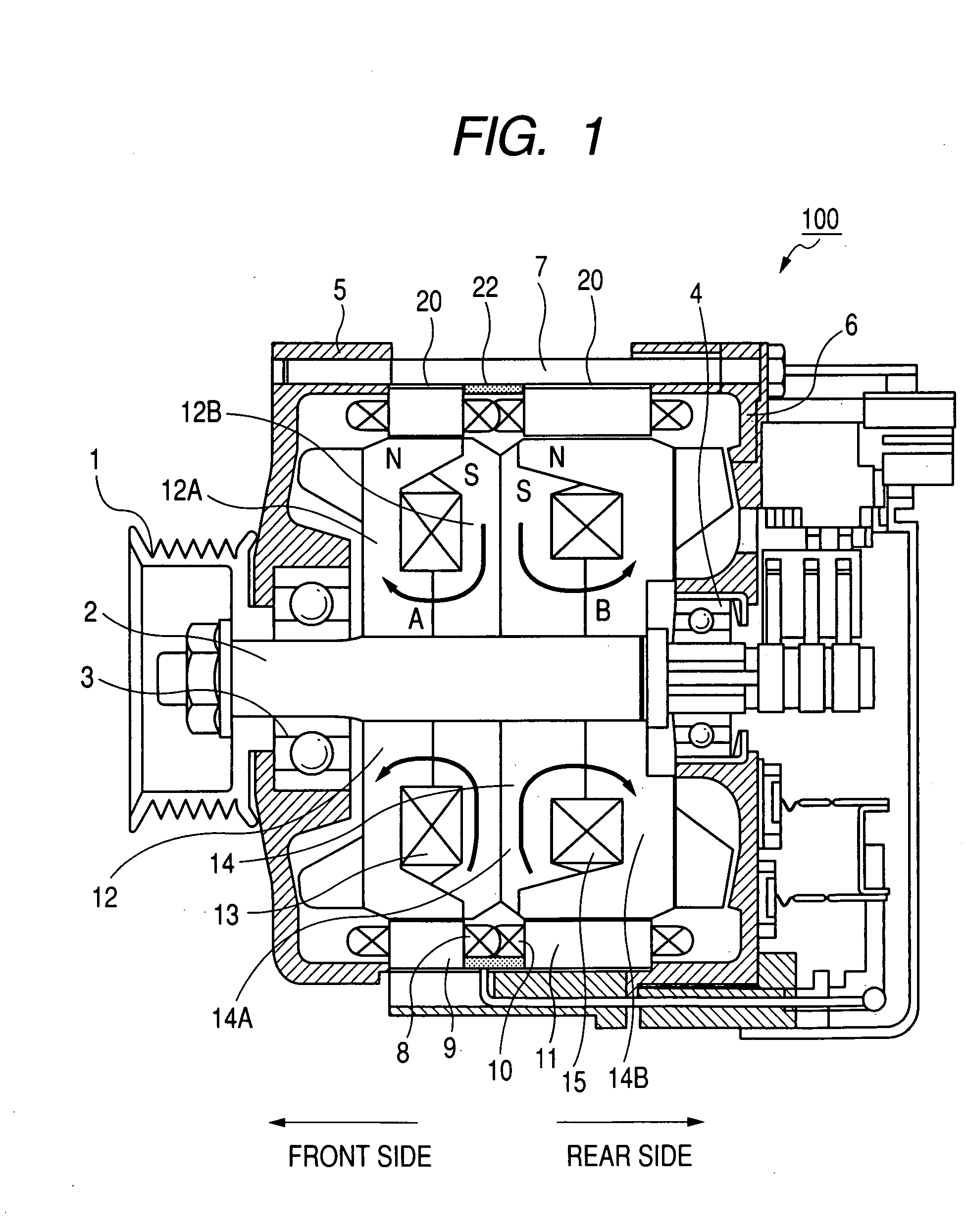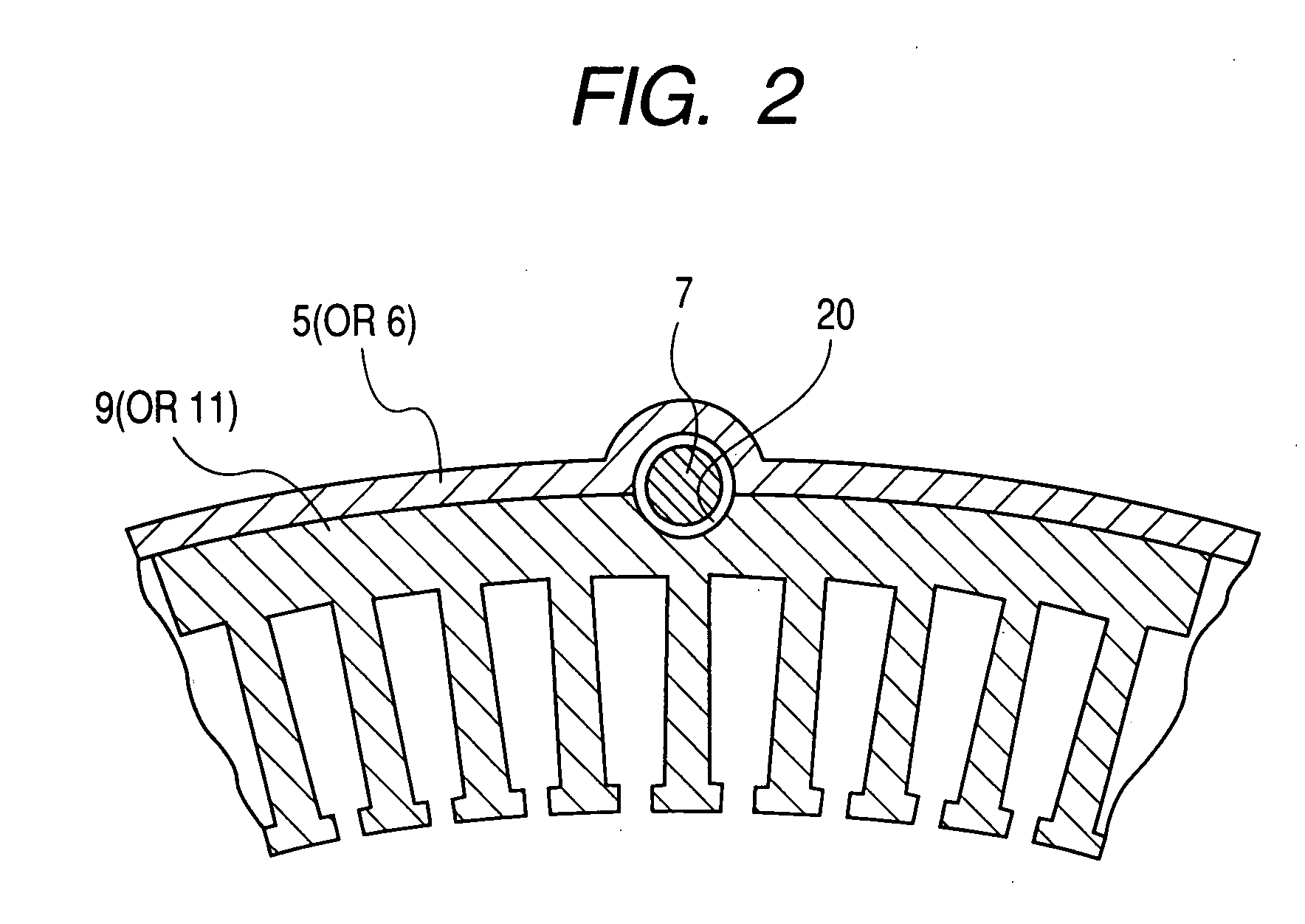Automotive tandem alternator having reduced axial length and capable of effectively suppressing magnetic leakage
- Summary
- Abstract
- Description
- Claims
- Application Information
AI Technical Summary
Benefits of technology
Problems solved by technology
Method used
Image
Examples
first embodiment
[0043]FIG. 1 shows the overall configuration of a tandem alternator 100 according to the first embodiment of the invention.
[0044]The alternator 100 is designed for use in an automobile. More specifically, the alternator 100 is configured to be driven by an engine (not shown) of the automobile via a pulley 1 that is fitted on a rotary shaft 2 of the alternator 100.
[0045]The rotary shaft 2 is rotatably supported by a front bearing 3 and a rear bearing 4, which are respectively provided in a front housing 5 and a rear housing 6 of the alternator 100. In other words, the front and rear housings 5 and 6 together rotatably support the rotary shaft 2 via the front and rear bearings 3 and 4. In the present embodiment, both the front and rear housings 5 and 6 are made of a nonmagnetic material.
[0046]A plurality of bolts 7 are provided to tightly connect the front and rear housings 5 and 6 together. More specifically, as shown in FIG. 1, each of the bolts 7 extends in the axial direction of t...
second embodiment
[0069]This embodiment illustrates an automotive tandem alternator 200 which has a structure almost identical to that of the alternator 100 according to the previous embodiment. Accordingly, only the differences therebetween will be described hereinafter.
[0070]Referring again to FIG. 1, in the alternator 100, the axial widths (i.e., the widths in the axial direction of the rotary shaft 2) of the outside and inside disc portions 12A and 12B of the field core 12 are equal to each other, and the axial widths of the inside and outside disc portions 14A and 14B of the field core 14 are also equal to each other. Accordingly, the sum of axial widths of the inside disc portions 12B and 14A are equal to that of the outside disc portions 12A and 14B.
[0071]In comparison, referring to FIGS. 3 and 4, in the alternator 200, both the axial widths of the inside disc portions 12B and 14A are reduced, so that the sum of axial widths of the inside disc portions 12B and 14A is less than that of the outs...
third embodiment
[0078]This embodiment illustrates an automotive tandem alternator 300 which has a structure almost identical to that of the alternator 200 according to the second embodiment. Accordingly, only the differences therebetween will be described hereinafter.
[0079]Referring again to FIG. 4, in the alternator 200, the inside disc portion 12B of the field core 12 and the inside disc portion 14A of the field core 14 are separately formed. Further, each of the claw portions 102 of the field core 12 extending from the inside disc portion 12B is aligned in the axial direction of the rotary shaft 2 with one of the claw portions 103 of the field core 14 extending from the inside disc portion 14A. In other words, the circumferential position (i.e., the position in the circumferential direction of the rotary shaft 2) of each of the claw portions 102 coincides with that of one of the claw portions 103.
[0080]In comparison, referring to FIG. 5, in the alternator 300, the inside disc portion 12B of the ...
PUM
 Login to View More
Login to View More Abstract
Description
Claims
Application Information
 Login to View More
Login to View More - R&D
- Intellectual Property
- Life Sciences
- Materials
- Tech Scout
- Unparalleled Data Quality
- Higher Quality Content
- 60% Fewer Hallucinations
Browse by: Latest US Patents, China's latest patents, Technical Efficacy Thesaurus, Application Domain, Technology Topic, Popular Technical Reports.
© 2025 PatSnap. All rights reserved.Legal|Privacy policy|Modern Slavery Act Transparency Statement|Sitemap|About US| Contact US: help@patsnap.com



